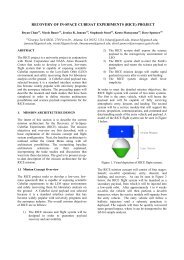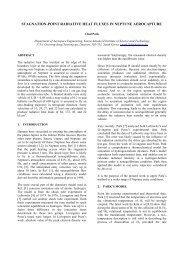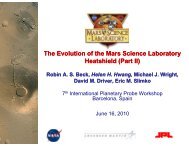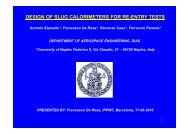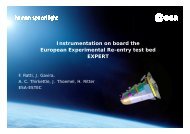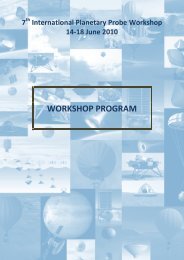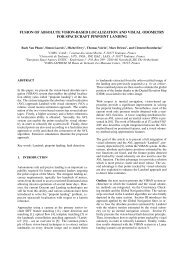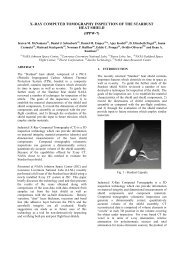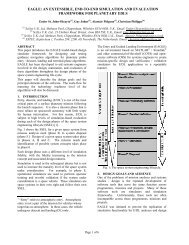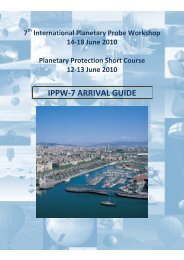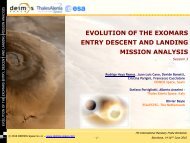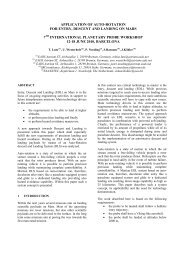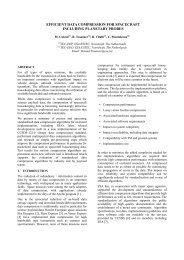Paper 342 - International Planetary Probe Workshop
Paper 342 - International Planetary Probe Workshop
Paper 342 - International Planetary Probe Workshop
You also want an ePaper? Increase the reach of your titles
YUMPU automatically turns print PDFs into web optimized ePapers that Google loves.
THE TITAN SATURN SYSTEM MISSION—A MULTI-PROBE<br />
MISSION TO TITAN AND ENCELADUS<br />
7 TH INTERNATIONAL PLANETARY PROBE WORKSHOP<br />
12–18 JUNE 2010, BARCELONA<br />
Kim Reh (1) , John Elliott (1)<br />
Tom Spilker (1) , Christian Erd (2) , Jonathan Lunine (3) , Jean-Pierre Lebreton (4) , Athena Coustenis (4) ,<br />
Andre Vargas (5) , Dennis Matson (1)<br />
(1)<br />
Jet Propulsion Laboratory, California Institute of Technology, 4800 Oak Grove Dr. Pasadena, CA 91109, USA,<br />
kim.r.reh@jpl.nasa.gov, john.o.elliott@jpl.nasa.gov, thomas.r.spilker@jpl.nasa.gov, dennis.l.matson@jpl.nasa.gov<br />
(2) ESA-ESTEC, European Space Research & Technology Centre, Keplerlaan 1, Postbus 299, 2200 AG Noordwijk (The<br />
Netherlands), cerd@rssd.esa.int<br />
(3) University of Arizona, Tucson AZ 85721, USA, jlunine@lpl.arizona.edu<br />
(4) Observatoire de Meudon, Observatoire de Paris, Section de Meudon, 5, place Jules Janssen, 92195 Meudon Cedex,<br />
France, athena.coustenis@obspm.fr, jean-pierre.lebreton@esa.int<br />
(5) CNES, 2 place Maurice Quentin, 75 039 Paris Cedex 01, France, dennis.l.matson@jpl.nasa.gov<br />
ABSTRACT<br />
It is becoming clear that any future mission to Titan<br />
would require the delivery and support of in situ probes<br />
to address high priority science questions raised by both<br />
the Cassini-Huygens mission and the international<br />
science community participating in recent NASA-ESA<br />
mission studies. The most recent studies have<br />
specifically identified the montgolfière hot air balloon<br />
(Titan’s rover) and lake lander as providing the highest<br />
value science return for future missions to Titan.<br />
Furthermore, results from science, technical, and<br />
management review of recent studies have focused<br />
current technical efforts on key areas for increasing the<br />
readiness of these in situ probes for launch. The purpose<br />
of this paper is to provide a technical overview of the<br />
Titan Saturn System Mission (TSSM) architecture and<br />
its elements and the progress and plans toward reducing<br />
risk and increasing readiness.<br />
TABLE OF CONTENTS<br />
1. INTRODUCTION ................................................ 1<br />
2. BASELINE MISSION DESCRIPTION ............... 2<br />
3. TSSM FLIGHT SYSTEM OVERVIEW .............. 4<br />
4. PATH FORWARD ............................................... 6<br />
5. TECHNICAL FOUNDATION ............................. 9<br />
6. SUMMARY AND CONCLUSIONS ................. 10<br />
REFERENCES ............................................................ 10<br />
ACKNOWLEDGEMENTS ........................................ 10<br />
BIOGRAPHY .............................................................. 10<br />
Copyright 2010. All rights reserved<br />
1<br />
1. INTRODUCTION<br />
The fascinating world revealed by the Cassini-Huygens<br />
mission has stimulated great interest in the science<br />
community in recent years. Several studies over the last<br />
decade have looked at Titan as a world tailor-made for<br />
application of techniques that would allow enhanced<br />
exploration. In 2007, the APL-led Titan Explorer study<br />
confirmed that an architecture consisting of an orbiter<br />
with lander and balloon in situ probes was optimal for a<br />
flagship mission to Titan. This study, along with the<br />
ESA TandEM study, formed the basis for the 2008<br />
Titan Saturn System Mission (TSSM) study to develop<br />
a mission that would expand on Cassini/Huygens’<br />
tantalizing discoveries at Titan and Enceladus, covering<br />
a wide range of planetary science disciplines—Geology,<br />
Geophysics, Atmospheres, Astrobiology, Chemistry,<br />
Magnetospheres—in a single NASA/ESA collaboration<br />
[1, 2].<br />
The TSSM baseline mission was derived from a careful<br />
consideration of alternative architectures as discussed in<br />
[1]. The baseline mission would consist primarily of a<br />
Titan orbiter spacecraft augmented with a solar electric<br />
propulsion (SEP) stage (Fig. 1), capable of meeting all<br />
Level 1 science requirements as imposed by study<br />
ground rules and the TSSM joint science definition team<br />
(JSDT), including Saturn system science as well as<br />
targeted science at Enceladus during an extended Saturn<br />
tour phase [1]. The baseline mission would also<br />
accommodate two ESA-provided in situ probes, a long-
lived montgolfière aerial vehicle that would<br />
circumnavigate the moon at a nominal altitude of 10 km<br />
(Fig. 2) and a battery-powered lander targeted at Titan’s<br />
northern lakes (Fig. 3). These probes would be delivered<br />
to Titan by the orbiter spacecraft and supported during<br />
their science mission with two-way data relay through<br />
the orbiter telecom assets (Fig. 4).<br />
The TSSM mission architecture represents a robust and<br />
scientifically rich implementation that would produce a<br />
giant leap in our understanding of Titan and Enceladus.<br />
2. BASELINE MISSION DESCRIPTION<br />
The baseline mission concept developed for TSSM<br />
would include a flight system comprised of an orbiter<br />
and two in situ probes. The flight system would travel<br />
by means of an inner planet gravity assist trajectory and<br />
reach Saturn approximately nine years after launch.<br />
Augmentation of ∆V is provided during roughly the first<br />
two-thirds of the trajectory by using an SEP stage,<br />
which would be jettisoned approximately five years into<br />
the mission (Fig. 5). Following the remainder of the<br />
cruise, the orbiter’s chemical propulsion subsystem<br />
would place the flight system into orbit around Saturn<br />
followed by approximately two years of Saturn system<br />
science, including a minimum of seven Enceladus<br />
flybys, while the flight system would use repeated<br />
satellite gravity assists<br />
Fig. 3. TSSM lake lander concept.<br />
and maneuvers to reduce the energy needed to insert<br />
into orbit around Titan (Fig. 6).<br />
The in situ probes delivered by the orbiter would<br />
include a montgolfière aerial vehicle and a lake lander.<br />
Current planning for the baseline mission is that the<br />
montgolfière probe would be released at the first Titan<br />
flyby after Saturn orbit insertion (SOI) for ballistic entry<br />
into Titan. The lander probe would be targeted and<br />
released at the second Titan flyby to ensure robust<br />
communications links during its primary mission. Titan<br />
orbit insertion would be accomplished at the end of the<br />
Saturn tour phase using the main engine. Capture into<br />
an elliptical Titan orbit would be followed by a twomonth<br />
aerobraking and aerosampling phase, leading to a<br />
circular 1500 km orbit for the final 20-month orbital<br />
science phase (Fig. 7).<br />
At an orbital altitude of approximately 1500 km, the<br />
flight system would orbit Titan approximately five<br />
times in an Earth day. A science planning payload was<br />
developed, consisting of six instruments (Table 1) in<br />
addition to radio science, and was estimated at 165 kg<br />
(including contingency) with an orbital average power<br />
of
Fig. 5. 2020 EVEE SEP baseline trajectory<br />
with arrows showing thrust periods and<br />
di ti<br />
Fig. 6. Planned Saturn tour phase showing<br />
orbits numbered from SOI to TOI.<br />
Fig. 7. Aerobraking phase<br />
orbits.<br />
Copyright 2010. All rights reserved<br />
Table 1. Orbiter model science instruments and science contributions.<br />
Inst. Description Science Contributions<br />
HiRIS High-Resolution Imager [in three colors (~2.0, 2.7, and<br />
5–6 µm)] and Spectrometer (near IR). Two spectral<br />
mapping bands 0.85 to 2.4 µm (5 nm spectral<br />
resolution) and 4.8 to 5.8 μm (10 nm spectral<br />
resolution)<br />
TiPRA<br />
PMS<br />
>20 MHz Titan Penetrating Radar and Altimeter. Two<br />
dipole antennas (1st one used for Enceladus and then<br />
ejected; 2nd for Titan orbit phase)<br />
Polymer Mass Spectrometer with M/ΔM ~10,000 for<br />
masses up to 10,000 Da<br />
SMS Sub-Millimeter Heterodyne spectrometer with<br />
scanning mirror. 300 kHz spectral resolution, 12 km<br />
spatial resolution.<br />
TIRS<br />
MAPP<br />
RSA<br />
Thermal Infrared Spectrometer Passively cooled<br />
Fourier Spectrometer 7–333 microns. Spectral<br />
resolution 0.125–15 cm -1 .<br />
3<br />
Global surface mapping at 50 m/pixel in three colors.<br />
Spectral mapping at 250 m/pixel. Surface composition and<br />
atmospheric studies.<br />
Global mapping of subsurface reflectors with 10 m height<br />
resolution in altimetry mode and better than 10 m in depth<br />
resolution. Lower data rate depth sounding mode with ~100<br />
m depth resolution. Approximately 1 km × 10 km spatial<br />
resolution.<br />
Upper atmospheric in situ analysis of gases and aerosol<br />
precursor aerosampling down to 600 km. Detection limit is<br />
better than 10 4 particles/cm 3 .<br />
Measure winds directly from Doppler. Temperature<br />
mapping from ~200–1000 km altitude; Obtain CO, H 2 O,<br />
nitrile and hydrocarbon profiles.<br />
Organic gas abundance, aerosol opacity and temperature<br />
mapping 30–500 km.<br />
Magnetometer. Tri-axial fluxgate sensors 0–64 Hz. Measure interaction of field with ionosphere: internal and<br />
Noise levels of the order 11 pTrms<br />
induced field.<br />
Energetic Particle Spectrometer. TOF analyzer with Measures ions in the energy range of 2 keV/nucleon to<br />
solid state detectors<br />
5 MeV/nucleon and electrons in the range from 20 to<br />
Langmuir <strong>Probe</strong>—Swept voltage/current probe.<br />
Plasma Spectrometer—Electrostatic analyzer system,<br />
with a linear electric field time-of-flight mass<br />
spectrometer.<br />
Radio Science and Accelerometer. Components are<br />
part of the spacecraft bus: USO, transponder, and<br />
accelerometers.<br />
1000 keV with 150° × 15° FOV.<br />
Measure thermal plasmas in Titan’s ionosphere over a range<br />
of densities from 10 to 10 6 cm -3 and temperatures from 0.01<br />
to 10 eV.<br />
Measures ion and electron fluxes at ~5 eV to a ~5 keV.<br />
M/ΔM~10.<br />
Lower stratosphere and troposphere temperature profile.<br />
Gravity field.<br />
Table 2. Key mission characteristics of the TSSM baseline mission concept.<br />
Architecture<br />
Orbiter with in situ probes<br />
Launch vehicle Atlas V 551<br />
Launch date 9/2020<br />
Trajectory<br />
Earth-Venus-Earth-Earth gravity assist<br />
Flight time to Saturn<br />
9 years
Saturn system tour phase<br />
24 months<br />
Number of close Enceladus encounters during the Saturn tour 7<br />
Number of Titan encounters during the Saturn tour 16<br />
Titan aerosampling phase<br />
2 months<br />
Titan orbital phase<br />
20 months<br />
Radiation design point*<br />
4.9 Tb<br />
>300 Gb – 1.3 Tb<br />
>500 Mb – 3.4 Gb<br />
3. TSSM FLIGHT SYSTEM OVERVIEW<br />
The TSSM baseline flight system would be composed<br />
of three elements—the orbiter, augmented by an SEP<br />
stage; a multi-mission radioisotope thermoelectric<br />
generator (MMRTG)-powered montgolfière; and a<br />
battery-powered lake lander.<br />
3.1 Titan Orbiter<br />
The TSSM orbiter (Fig. 8) concept is a three-axis<br />
stabilized spacecraft powered by radioisotope power<br />
systems (RPSs) that has strong similarity to the Cassini<br />
orbiter. The TSSM orbiter would include an articulated<br />
4 m high gain antenna (HGA) using Ka-band for highrate<br />
science data downlink. A planning payload of six<br />
instruments plus radio science is accommodated with<br />
the model instruments located on a payload deck, as<br />
well as other locations on the spacecraft dictated by<br />
their observational requirements. Accommodation for<br />
the two in situ probes would be provided at attachment<br />
points along the body of the orbiter. Five advanced<br />
stirling radioisotope generators (ASRGs) would power<br />
the spacecraft, with four providing a total of 540 W of<br />
electrical power at end of mission (approximately 13<br />
years after launch) and the fifth unit carried as a spare.<br />
The TSSM architecture would also be compatible with<br />
use of MMRTGs if directed by NASA. Redundant<br />
25 A-hr Lithium-ion (Li-ion) batteries would provide<br />
for power demands that exceed the RPS capability<br />
during the science mapping orbit and at other times<br />
during the mission. The launch mass of the flight system<br />
is estimated at 6203 kg. This is within current Atlas V<br />
551 capability of 6265 kg to the required launch energy.<br />
The flight system design includes ample mass and<br />
power margins in excess of what is typically required at<br />
this stage of maturity. Use of SEP would allow for<br />
significant mass growth of up to 300 kg beyond the<br />
current margins with a minimal impact of up to<br />
1.5 years longer flight time.<br />
Copyright 2010. All rights reserved<br />
4<br />
The TSSM flight system would incorporate an SEP<br />
stage for efficient ΔV augmentation during the first half<br />
of the cruise trajectory, which is jettisoned after<br />
approximately five years. The SEP stage for TSSM was<br />
developed as a simple, bolt-on augmentation built<br />
around and incorporating the function of a launch<br />
vehicle adapter (LVA). The basic LVA structure would<br />
be used to support two Orion-derived 7.5 kW Ultraflex<br />
solar array wings, as well as three NEXT ion thrusters,<br />
power processing units (PPUs), xenon tanks, and<br />
electronics necessary for the control and operation of<br />
this self-contained stage. Interfaces with the launch<br />
vehicle and orbiter were kept simple to allow the<br />
flexibility to operate with or without the SEP stage<br />
without significant changes to orbiter configuration.<br />
3.2 Montgolfière<br />
The montgolfière in situ probe concept designed for<br />
TSSM is a hot air balloon. An MMRTG would provide<br />
both electrical power (~100 W) to the gondola and heat<br />
(~1.7 kW) for buoyancy. The balloon envelope concept,<br />
nearly 11 m in diameter, uses double-wall construction<br />
for improved thermal insulation. An aeroshell with a<br />
heat shield, and a back shell, protect the montgolfière<br />
from the thermal load of entry (Fig. 9).<br />
The orbiter would carry the montgolfière through SOI to<br />
the subsequent apoapsis, releasing it on a direct ballistic<br />
trajectory for entry at the first Titan flyby. After entry, a<br />
pilot chute would pull off the back shell, deploying the<br />
main parachute that extracts the montgolfière from its<br />
heat shield.<br />
When the system has descended to ~40 km altitude the<br />
balloon envelope would deploy and fill with ambient<br />
air, aided by the ram effect of the continuing descent.<br />
Heat from the MMRTG suspended within the envelope<br />
would warm the air to positive buoyancy at ~8 km<br />
altitude. Once at buoyant equilibrium, the montgolfière<br />
would drift passively with the winds at 1–2 m/s, actively<br />
maintaining its nominal 10 km altitude via barometric<br />
measurements and a vent valve at the balloon’s zenith.
Fig. 2 depicts the montgolfière in stable flight. The 10<br />
km altitude was chosen to meet all science requirements<br />
while avoiding the risk from methane icing above ~14<br />
km and the potential risks associated with near surface<br />
operations.<br />
The total estimated mass of the montgolfière probe and<br />
its aeroshell was estimated at 571 kg including<br />
contingency. Its 144 kg gondola includes a 25 kg<br />
payload allocation for the instruments listed in Table 3.<br />
Data would be transmitted to the orbiter at various rates<br />
during its Saturn tour via a steerable 50 cm HGA for<br />
relay to Earth.<br />
Plans for future studies include the possibility of<br />
instrumenting the montgolfière’s heat shield for<br />
geophysical measurements. Spare volume between the<br />
heat shield and the gondola might accommodate, for<br />
example, a micro-accelerometer, a radio science<br />
instrument, an acoustic package, and a magnetometer.<br />
These would be investigated as opportunity instruments<br />
to enhance the geophysical science return.<br />
4-m m HGA<br />
Avionics (3)<br />
4.5 N RCS<br />
Thrusters<br />
(16 )<br />
Fuel Tank<br />
ESA Montgolfiere<br />
Instrument<br />
Radiator<br />
Shade<br />
Orbiter<br />
ESA Lander<br />
Ox<br />
Pressurant<br />
Tank<br />
ASRG (5)<br />
Ox Tank<br />
890 N HiPAT engine<br />
(enclosed in SEP stage)<br />
15 kW Ultraflex Solar<br />
Arrays (2 wings, stowed)<br />
NEXT Ion<br />
Thrusters (3)<br />
Xenon Prop<br />
Tanks (3)<br />
SEP Stage<br />
Fig. 8. Flying a chemically propelled mission to Titan would result in a flight system that has many similarities to<br />
Cassini-Huygens, however the more capable instrumentation and focused operational plan for TSSM would enable a<br />
giant leap in understanding beyond Cassini-Huygens. This Fig. shows the TSSM flight system concept.<br />
Back Shell<br />
Montgolfière<br />
Aeroshell<br />
Heat Shield<br />
Stowed<br />
balloon<br />
Mortar & drogue<br />
parachute<br />
Main parachute<br />
Steerable HGA<br />
Gondola skin<br />
Platform<br />
MMRTG<br />
Labyrinth sealing<br />
Fig. 9. Conceptual design of the montgolfière integrates Huygens heritage with balloon probe. An exploded view of<br />
entry system aeroshell is shown.<br />
Copyright 2010. All rights reserved<br />
5
3.3 Lake Lander<br />
The orbiter spacecraft would also carry the lake lander<br />
in its aeroshell and release it during the second Titan<br />
flyby. After releasing the lander, the orbiter would be in<br />
continuous contact with it, allowing the orbiter to<br />
monitor the lander’s trajectory and to collect and relay<br />
to Earth all telemetry data.<br />
Entry and descent would largely build upon heritage<br />
from Huygens, and the early phases would be similar to<br />
those described for the montgolfière above. Unlike<br />
Huygens, in the TSSM baseline, the lander would<br />
descend on a single main parachute, thus spending more<br />
time in descent (approximately 5 hours) while<br />
performing atmospheric analysis of high northern<br />
latitudes. The floating lander design would provide<br />
enough energy to perform scientific measurements for<br />
3–4 hours after landing in the lake.<br />
Table 3. Model instruments for the montgolfière.<br />
Inst. Description Science Contributions<br />
BIS Balloon Imaging<br />
Spectrometer<br />
(1–5.6 µm).<br />
Mapping for troposphere<br />
and surface composition<br />
at 2.5 m resolution<br />
VISTA-B<br />
ASI/<br />
MET<br />
TEEP-B<br />
TRS<br />
TMCA<br />
Visual Imaging<br />
System with two<br />
wide angle<br />
stereo cameras<br />
& one narrow<br />
angle camera.<br />
Atmospheric<br />
Structure<br />
Instrument and<br />
Meteorological<br />
Package.<br />
Titan Electric<br />
Environment<br />
Package<br />
> 150 MHz<br />
radar sounder<br />
1-600 Da Mass<br />
spectrometer<br />
Copyright 2010. All rights reserved<br />
Detailed geomorphology<br />
at 1 m resolution<br />
Record atmosphere<br />
characteristics &<br />
determine wind velocities<br />
in the equatorial<br />
troposphere<br />
Measure electric field in<br />
the troposphere (0–<br />
10 kHz) and determine<br />
connection with weather.<br />
Detection of shallow<br />
reservoirs of<br />
hydrocarbons, depth of<br />
icy crust and better than<br />
10 m resolution<br />
stratigraphic of<br />
geological features.<br />
Analysis of aerosols and<br />
determination of noble<br />
gases concentration and<br />
ethane/methane ratios in<br />
the troposphere<br />
MAG Magnetometer Separate internal and<br />
external sources of the<br />
field and determine<br />
whether Titan has an<br />
intrinsic and/or induced<br />
magnetic field.<br />
MRST<br />
Radio Science<br />
using spacecraft<br />
telecom system<br />
Precision tracking of the<br />
montgolfière<br />
6<br />
Fig. 10 shows a conceptual design of the lander and an<br />
exploded view of the stowed configuration.<br />
Accommodating instrumentation and system support<br />
equipment inside the lander aids optimizing thermal<br />
balance. Environmental sensors and an omni-directional<br />
antenna would be mounted on the upper side (Fig. 10).<br />
The lander’s total launch mass is estimated at 190 kg,<br />
including 32 kg of science instrumentation as listed in<br />
Table 4.<br />
4. PATH FORWARD<br />
Following completion of the TSSM study in 2008,<br />
NASA and ESA review panels evaluated the concept<br />
and identified risks that would need further attention to<br />
enable the mission to proceed. The NASA panel<br />
focused primarily on the NASA-provided orbiter and<br />
identified a number of risks to the design presented in<br />
the study that would require future action. Review by<br />
the TSSM design team recognized these risks, but<br />
determined that they are not out of the norm for<br />
missions at this stage of development and saw no “tall<br />
tent poles” requiring significant additional investment at<br />
this time.<br />
The ESA review panel identified a number of risks,<br />
primarily related to development of the montgolfière,<br />
the one element of TSSM that is truly unique to this<br />
mission concept. A number of these technical risks were<br />
determined by the TSSM team to be excellent<br />
candidates for early mitigation activities. These<br />
included:<br />
• Balloon deployment and inflation upon arrival at<br />
Titan<br />
• Balloon packaging and thermal management inside<br />
the aeroshell during cruise<br />
Fig. 10. Conceptual design of the lake lander in the<br />
stowed configuration. An exploded view of the Huygens<br />
heritage entry aeroshell is shown
• Interface complexity issues between the balloon, its<br />
MMRTG, and the aeroshell<br />
• Integration of the MMRTG during ground<br />
processing<br />
In addition to these montgolfière-related issues, the<br />
TSSM team identified development of in situ instrument<br />
and sampling systems for the cryogenic environment<br />
and high performance orbiter remote sensing<br />
instruments as areas for early risk reduction activities.<br />
To address these concerns, a multi-year plan has been<br />
developed that includes leverage of international and<br />
inter-center expertise, including participation by JPL,<br />
Caltech and CNES.<br />
The plan being discussed would proceed in a two-step<br />
approach as shown in Figs. 11 and 12. Step 1 would<br />
focus on risk reduction activities critical to addressing<br />
basic architectural driving questions that would allow a<br />
baseline to be defined. This would be done in parallel<br />
and in resonance with the SolarSystem2012 planetary<br />
science Decadal Survey and OPAG Titan Working<br />
Group recommendations to ensure risk reduction<br />
activities are executed in areas where they will have<br />
maximum value to a future science mission. Once<br />
preliminary risk reduction activities are completed and<br />
baseline architectures are established, the next step in<br />
the plan would proceed. In Step 2, a comprehensive and<br />
focused technical risk reduction program would advance<br />
the maturity of the technical implementation to a state<br />
of readiness required for initiation of a future mission.<br />
Examples of key products delivered in Step 1 include:<br />
• Balloon thermodynamic feasibility and<br />
quantification of performance margins for alternative<br />
architectures<br />
• Selection of baseline balloon material<br />
• Preliminary flight balloon qualification plan<br />
• Plans for Titan analog balloon experiments<br />
(TABEX)<br />
Table 4. Model instruments for the lake lander.<br />
Inst. Description Science Contributions<br />
TLCA Titan Lander<br />
Chemical Analyzer<br />
with 2-dimensional<br />
gas chromatographic<br />
columns and TOF<br />
mass spectrometer.<br />
Dedicated isotope<br />
mass spectrometer.<br />
Perform isotopic<br />
measurements,<br />
determination of the<br />
amount of noble gases<br />
and analysis of complex<br />
organic molecules up to<br />
10,000 Da.<br />
TiPI<br />
ASI/<br />
MET-<br />
TEEP<br />
SPP<br />
LRST<br />
Titan <strong>Probe</strong> Imager<br />
using Saturn shine<br />
and a lamp<br />
Atmospheric<br />
Structure Instrument<br />
and Meteorological<br />
Package including<br />
electric<br />
measurements<br />
Surface properties<br />
package<br />
Radio Science using<br />
spacecraft telecom<br />
system<br />
Provide context images<br />
and views of the lake<br />
surface.<br />
Characterize the<br />
atmosphere during the<br />
descent and at the<br />
surface of the lake and<br />
to reconstruct the<br />
trajectory of the lander<br />
during the descent.<br />
Characterize the<br />
physical properties of<br />
the liquid, depth of the<br />
lake and the magnetic<br />
signal at the landing<br />
site.<br />
Precision tracking of<br />
lander<br />
• Definition of baseline aerobot architecture<br />
Examples of key products delivered in Step 2 include:<br />
• A detailed concept definition<br />
• Manufacturing feasibility proven with full scale<br />
prototypes<br />
• Packaging and storage approach validated with life<br />
testing<br />
• Deployment and inflation approach validated with<br />
simulation and experiments<br />
• Operational performance measured with long<br />
duration Titan analog balloon experiments<br />
Copyright 2010. All rights reserved<br />
7
Fig. 11. Proposed plan for moving forward involves a two-step risk reduction approach.<br />
Titan Aerobot Risk Retirement<br />
Plan Overview<br />
Balloon Thermodynamics<br />
Balloon Mechanics<br />
Deployment and Inflation<br />
Packaging and Storage<br />
Operations and Performance<br />
Systems Engineering & Conceptual Design<br />
Preliminary Balloon System Qual. Plan<br />
Large Scale Cryogenic Testing<br />
Titan Analog Balloon Experiments (TABEX)<br />
CY 2009 CY 2010 CY 2011 CY 2012 CY 2013 CY2014 CY2015<br />
FY 2009 FY 2010 FY 2011 FY 2012 FY 2013 FY2014 FY2015<br />
Q3 Q4 Q1 Q2 Q3 Q4 Q1 Q2 Q3 Q4 Q1 Q2 Q3 Q4 Q1 Q2 Q3 Q4 Q1 Q2 Q3 Q4 Q1 Q2 Q3 Q4<br />
Step 1: Establish Baseline Aerobot Approach<br />
Key Decision Pt<br />
Step 2: Comprehensive Technical Risk Retirement<br />
Risk Retirement Task Complete<br />
Quantification of uncertainties and margins<br />
Development of lighter weight balloon materials<br />
Assessment of mobility options<br />
Full scale prototype fabrication<br />
EDI simulation and subscale testing to quantify margins<br />
Full scale testing, model validation and performance prediction<br />
Component and subscale testing to evaluate alternate approaches<br />
Full scale life testing<br />
Trajectories meet science needs<br />
Development of autonomous capabilities and operational scenarios<br />
System design and margin quantification<br />
Development of complete balloon and entry vehicle configuration<br />
Preliminary qualification plan<br />
What is required for full scale cryo testing?<br />
Planning for analog balloon flight experiments<br />
Full scale Titan analog balloon fabrication and flight testing<br />
Fig. 12. Titan aerobot risk reduction plan addresses architectural defining questions leading to<br />
definition of baseline approach and followed by comprehensive risk mitigation.<br />
Copyright 2010. All rights reserved<br />
8
5. TECHNICAL FOUNDATION<br />
The risk reduction plan would start from a solid base of<br />
analysis and testing already performed. Work has been<br />
ongoing at JPL on technologies for development and<br />
operation of planetary balloons, and much of this work<br />
has specifically focused on montgolfière designs.<br />
5.1 Balloon Deployment and Inflation<br />
The inflation of the montgolfière envelope, while<br />
similar to the parachute deployment demonstrated on<br />
the Huygens probe, is in many ways a unique operation<br />
that must be demonstrated to ensure a low-risk design.<br />
This operation has been addressed in a series of tests<br />
over the last few years. Most recently, deployment and<br />
inflation testing was performed on a 4.5 m balloon,<br />
using a configuration with a MMRTG mock-up<br />
suspended in the same manner as the proposed TSSM<br />
concept. This successful testing is illustrated in Fig. 13.<br />
5.2 Balloon Cruise Thermal Management<br />
Heat rejection from the MMRTG during cruise is a<br />
significant design challenge for the montgolfière, but<br />
one which is not unique to the TSSM concept.<br />
Currently, the Mars Science Laboratory (MSL) mission<br />
is addressing the same concern with respect to their<br />
MMRTG-based power system. The MSL solution of a<br />
remotely mounted radiator with a pumped cooling loop<br />
for the MMRTG is one which can also be adopted for<br />
the montgolfière (Fig. 14). The team will review the<br />
lessons learned from the MSL experience and<br />
incorporate those into risk reduction efforts specifically<br />
targeted to the longer duration cruise that would be a<br />
characteristic of any future Titan mission.<br />
5.3 Montgolfière Performance Modeling and Testing<br />
One of the areas most critical to development of the<br />
Titan montgolfière is that of performance modeling and<br />
testing. Given the known characteristics of the Titan<br />
atmosphere and uncertainties both in our understanding<br />
and in expected weather effects, it will be crucial to<br />
develop detailed analytical models, verified by testing.<br />
Considerable work has already begun in these areas,<br />
including computational fluid dynamics (CFD)<br />
modeling of Titan montgolfière thermodynamics (Fig.<br />
15). Cryogenic testing of sub-scale balloons in a<br />
simulated Titan environment has been performed by<br />
Julian Nott in collaboration with JPL and Caltech to<br />
validate buoyancy and heat transfer models critical to<br />
verifying vehicle performance and assessing margins.<br />
Fig. 13. Successful aerial deployment and inflation test<br />
on 4.5 m balloon (300–400 m altitude)<br />
Fig. 14. ESA design for the TSSM montgolfière builds<br />
on MSL cruise configuration.<br />
Copyright 2010. All rights reserved<br />
9
ACKNOWLEDGEMENTS<br />
Some of the research described in this paper was carried<br />
out at the Jet Propulsion Laboratory, California Institute<br />
of Technology, under a contract with the National<br />
Aeronautics and Space Administration.<br />
Johns Hopkins University/Applied Physics Laboratory,<br />
NASA Glenn Research Center, European Space<br />
Agency, and the French Space Agency CNES<br />
contributed to the research described in this paper.<br />
Fig. 15. CFD modeling of Titan montgolfière<br />
thermodynamics.<br />
6. SUMMARY AND CONCLUSIONS<br />
A broad range of studies assessing architecture options<br />
for the exploration of Titan have been performed over<br />
several decades by institutions including NASA, JPL,<br />
APL, ESA and CNES. While these studies have<br />
involved a variety of science definition teams with<br />
sometimes differing science objectives, a common<br />
element seen in all of these architectures is the<br />
recommendation of aerial and surface probes for in situ<br />
exploration. Partly as a result of these architectural<br />
findings, a significant amount of technology<br />
development has been completed toward reducing the<br />
implementation risks for such probes. This technology<br />
work has answered many initial questions, but<br />
significant additional risk reduction activities will be<br />
needed to ensure flight readiness.<br />
To prepare for the next mission to Titan, a risk<br />
reduction plan has been developed that responds<br />
directly to the major findings identified by NASA and<br />
ESA review boards in their review of the 2008 TSSM<br />
concept. This plan includes joint JPL and CNES efforts<br />
to mature the readiness of a Titan montgolfière probe, as<br />
well as efforts to demonstrate readiness of cryogenic in<br />
situ instruments and sampling systems. Completion of<br />
these activities is key to enabling future multi-probe in<br />
situ missions to Titan.<br />
REFERENCES<br />
[1] TSSM Final Report on the NASA Contribution to a<br />
Joint Mission with ESA, 3 November 2008, JPL D-<br />
48148, NASA Task Order NMO710851.<br />
[2] TSSM NASA/ESA Joint Summary Report, 15<br />
November 2008, ESA-SRE(2008)3, JPL D-48442,<br />
NASA Task Order NMO710851.<br />
Special acknowledgement goes to Dennis Matson,<br />
Candice Hansen, John Elliott, Nathan Strange, David<br />
Mohr, Melissa Jones, Pat Beauchamp, Christophe Sotin,<br />
Tom Spilker, Sarah Hornbeck (Jet Propulsion<br />
Laboratory); Jonathan Lunine (University of Arizona);<br />
Athena Coustenis (Observatoire de Paris-Meudon,<br />
France); Jean-Pierre Lebreton and Christian Erd (ESA-<br />
ESTEC); Andre Vargas (CNES); and the entire<br />
US/European JSDT for their extensive contributions to<br />
this material.<br />
BIOGRAPHY<br />
Kim R. Reh has a<br />
broad base of<br />
program, project, and<br />
line organization<br />
experience that spans<br />
project formulation<br />
through<br />
implementation. His<br />
experience includes significant interaction with the<br />
science community, working with international partners<br />
and implementing projects according to NASA<br />
requirements for management of flight projects.<br />
Kim is currently the Deputy Program Manager for JPL’s<br />
Solar System Exploration Mission Formulation Office.<br />
He is also the Lead for Titan mission formulation and<br />
risk reduction activities.<br />
Kim received his BSE from the University of Michigan,<br />
MSE from California State Polytechnic University,<br />
Business Management Certificate from the University<br />
of California Riverside, and Certificate of Executive<br />
Management at Caltech. Additionally, Kim has taken<br />
many continuing education courses in technical and<br />
management fields.<br />
John Elliott is a senior engineer in JPL’s<br />
Lunar and <strong>Planetary</strong> Mission Concepts<br />
group. He is currently leading studies in<br />
support of the NRC Decadal Survey in<br />
addition to ongoing work in the<br />
development of concepts for robotic<br />
Copyright 2010. All rights reserved<br />
10
lunar exploration. He recently served as Lead Flight<br />
Systems Engineer on the Titan Saturn System Mission<br />
study and prior to that was Project Element Manager for<br />
JPL’s system engineering efforts on the Constellation<br />
Program. Mr. Elliott’s past experience includes six<br />
years in the terrestrial nuclear power industry with<br />
Bechtel Corporation in addition to 18 years in aerospace<br />
systems at TRW and JPL.<br />
Copyright 2010. All rights reserved<br />
11



